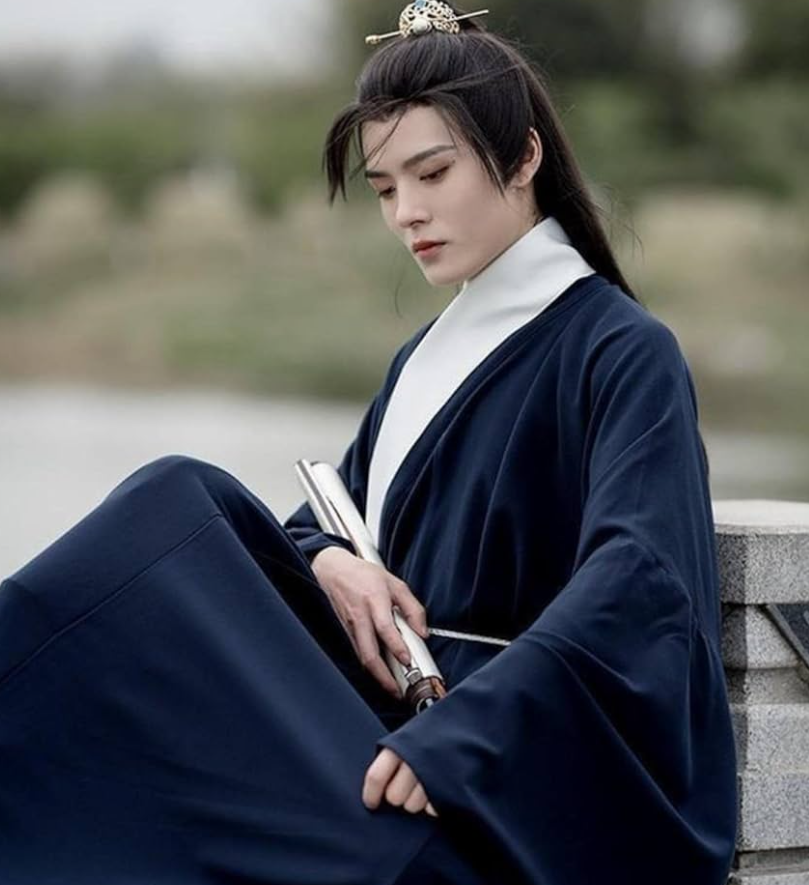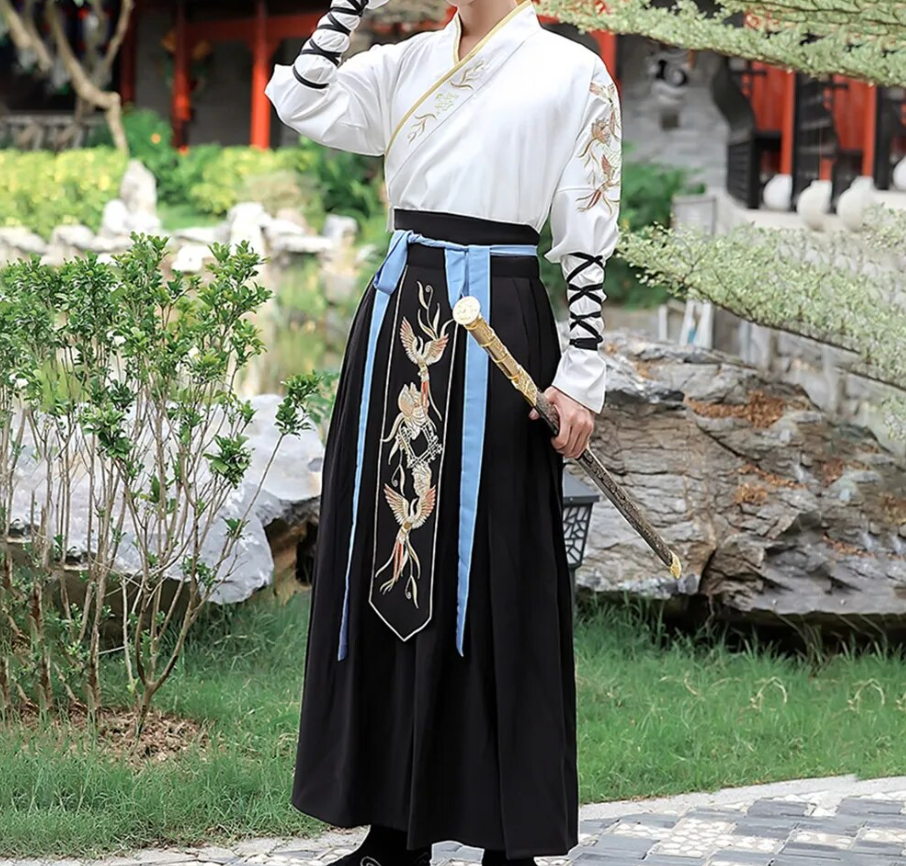The name of the Chinese man’s costume is often referred to as “Hanfu.”
Introduction
Throughout China’s extensive history, male attire has witnessed remarkable transformations. Reflecting the nation’s cultural, political, and social changes, men’s clothing became more than just a covering; it turned into a symbol of status, heritage, and even philosophy.

Brief history of Chinese male attire
Starting from the era of ancient dynasties like the Han and Tang, Chinese men predominantly wore Hanfu, a traditional garment characterized by its cross-collar and tied with a sash. As dynasties changed, so did the styles and materials used. For instance, during the Ming Dynasty, silk became the preferred fabric for the elite due to its sheen and quality, costing around 5 silver taels for a high-quality piece (an approximate equivalent of $500 today when adjusted for historical value).
During the Qing Dynasty, influenced by the Manchu rulers, the Qipao or Changshan became popular. This straight, long dress-like garment was simpler in design, but its material and embroidery dictated its value. An intricately designed Changshan could easily cost 10 silver taels, translating to about $1,000 in today’s value.
Evolution of Chinese fashion
By the 20th century, Western influences began to seep into Chinese fashion. The Republic era saw the introduction of suits and western-style clothing, especially among urban elites. In the 1970s and 1980s, with China’s opening up, global fashion trends started making their mark. The efficiency in producing these modern clothes was remarkable, with factories churning out garments at speeds of 100 pieces per hour, keeping costs as low as $10-20 per piece.
However, in the 21st century, there’s been a nostalgic resurgence in traditional attire. Younger generations, driven by a desire to reconnect with their roots and the appeal of the unique aesthetics, have started embracing Hanfu and other traditional garments. These modern versions, though inspired by history, come with updated specifications and materials to suit contemporary needs. For instance, while the traditional Hanfu prioritized materials like silk, modern versions might utilize more cost-effective and durable materials, with prices ranging from $50 for basic designs to upwards of $500 for premium ones.
Traditional Chinese Male Attire
Chinese attire, spanning several millennia, has manifested itself in various designs and fabrics. It’s essential to distinguish between the different styles that have marked significant epochs in Chinese history. These traditional outfits are not just garments but reflections of the cultural, socio-economic, and philosophical landscapes of their times.
Hanfu: Ancient Chinese Clothing
The Hanfu, dating back over 3,000 years, is perhaps the most emblematic of all traditional Chinese male attire. Recognized by its cross-collar, tied with a sash, and typically layered, Hanfu was predominantly worn during the Han Dynasty. Made primarily of silk, a high-quality Hanfu could cost around 5 silver taels, equivalent to approximately $500 today. The material was prized not just for its aesthetic appeal but also for its quality and longevity, often lasting for over a decade with proper care. Hanfu also had various designs, with each corresponding to a specific status or occasion.
Changshan: The Long Shirt
Emerging during the late Qing Dynasty, the Changshan (often referred to as Cheongsam when talking about the female version) is a straight-lined, robe-like garment. Unlike the Hanfu, Changshan was simpler, often reaching down to the heels. While the base design was simple, the elegance often came from embroidery or the quality of the material. Depending on the intricacy of the designs, the value could range from 7 to 15 silver taels, which would be roughly between $700 to $1,500 in today’s currency.
Magua: Traditional Jacket
The Magua is a traditional jacket worn over the main garment. Originating from the Manchu ethnic group, it became popular during the Qing Dynasty. This jacket, often made of materials like silk or cotton, varied in price. A silk Magua, known for its sheen and durability, might set someone back by 3 silver taels or around $300 today. Its main advantage was the added layer it provided against cold, especially in Northern China.
Yishang: Traditional Robe
Yishang, a type of traditional robe, was often reserved for formal occasions or by those of higher social status. Similar to other traditional garments, it was typically made of high-quality materials like silk. The cost, determined by the fabric and the craftsmanship, ranged between 6 to 12 silver taels, translating to about $600 to $1,200 in today’s currency. Its timeless design ensured that it remained a favorite for ceremonies and rituals, especially because of the gravitas it added to the wearer’s presence.
Popular Chinese Headgears for Men
Headgears in China have always held a special place, not only offering protection from the elements but also symbolizing the wearer’s social status, profession, and even beliefs. These adornments, worn atop the head, often communicated more about the wearer than any other piece of attire. Throughout different eras, various types of headgears became popular, each telling its own story.
Guan: Official’s Cap
The Guan was more than just a headgear; it was a sign of power and status. Predominantly worn by officials and scholars during ancient Chinese dynasties, it symbolized their esteemed positions within society. Made from materials like silk, bamboo, and sometimes adorned with ornate decorations, a Guan could cost a government official up to 4 silver taels, which is roughly $400 in today’s valuation. The specific design and quality of a Guan could often hint at the official’s rank within the bureaucracy. The taller the hat, the higher the rank, making the height specification crucial. The most prestigious Guans were about 12 inches tall and were often paired with robes of similar importance.
Futou: Cloth Headgear
The Futou was a simpler and more utilitarian form of headgear. Made primarily of cloth, it was wrapped around the head, protecting the wearer from both sun and cold. This headgear was versatile and used by common men, especially those working outdoors. Due to its simplicity and material, a Futou was considerably cheaper, often costing a commoner about two copper coins, equivalent to $5 today. Its advantage was its adaptability. It could be worn in various ways, depending on the weather and the task at hand. Its design emphasized functionality over aesthetics, focusing on the wearer’s comfort.

Maozi: General term for hat
Maozi is a broad term used to refer to hats in China. Over time, influenced by both indigenous and foreign trends, the Maozi has seen several variations. From woolen caps introduced during chilly winters to modern baseball caps reflecting global influences, the term encompasses a wide range. The cost of a Maozi could vary significantly based on its type, material, and craftsmanship. For instance, a high-quality woolen Maozi for winter could cost around 1 silver tael ($100 today), while a simple cotton one for daily wear might be priced at a few copper coins ($10 today). The versatility and variety of the Maozi make it an evergreen headgear choice for many.
Modern Interpretations of Traditional Attire
The constant evolution of fashion sees past trends returning with a contemporary twist. China, with its vast cultural history and fashion legacy, isn’t immune to this cycle. Modern designers and trendsetters are revisiting traditional attire, blending age-old aesthetics with today’s sensibilities, resulting in a unique fusion of old and new.
The renaissance of Hanfu among the younger generation
A noticeable trend is the resurgence of Hanfu among China’s youth. Once a symbol of ancient Chinese culture, it’s now a statement of national pride and identity. Young enthusiasts, both men and women, wear Hanfu not just for special occasions but as everyday attire. This revival isn’t merely about clothing but about reconnecting with cultural roots.
Modern Hanfu often includes innovative materials and designs. While traditional Hanfu primarily used silk, contemporary versions might employ synthetic materials for durability and cost-effectiveness. A high-quality modern Hanfu set, complete with accessories, can cost anywhere from $100 to $500, depending on the material and craftsmanship.
Moreover, fashion events and Hanfu gatherings have become common in urban areas. Universities even host Hanfu days, where students don traditional garb, reinforcing the outfit’s modern-day relevance.
Contemporary fusion and fashion trends
While Hanfu makes a significant comeback, other fusion trends are emerging. Designers are integrating traditional elements, such as embroidery patterns, silk materials, and traditional motifs, into modern clothing items like jackets, shirts, and even sneakers.
Brands are capitalizing on this trend. For instance, a high-end jacket with traditional Chinese embroidery might fetch a price of $1,000, given the labor-intensive detailing and quality of materials used. On the other hand, everyday wear with subtle traditional touches can range from $50 to $200.
This fusion isn’t limited to clothing. Accessories like bags, shoes, and jewelry now incorporate traditional designs, from dragons and phoenixes to floral motifs, appealing to both domestic and international markets.
Pop culture, particularly films and television series set in historical periods, significantly influences these trends. They reintroduce audiences to the glamour of ancient China, sparking interest in traditional attire. Social media also plays a pivotal role, with influencers showcasing ways to blend the old with the new seamlessly.
Important Cultural and Ritual Uses
Chinese attire isn’t just about aesthetics or daily wear; it’s deeply intertwined with the nation’s culture, traditions, and rituals. These garments often hold significant symbolic meanings, playing pivotal roles in ceremonies, performances, and festivals. Their designs, colors, and patterns convey messages about the event, the participants, and the values being celebrated.

Clothing for ceremonies and festivals
Many Chinese ceremonies and festivals are incomplete without specific traditional attire. These outfits are often chosen based on the event’s significance and the message it aims to convey.
For instance, during the Qingming Festival, people often wear somber and muted colors to pay respect to their ancestors. A traditional outfit for this occasion might range from $60 to $150, depending on the intricacy and material.
On the other hand, the Lunar New Year, a time for joy and celebration, sees a burst of red, as the color symbolizes luck and prosperity. A high-quality silk outfit for this festival, adorned with gold embroidery depicting dragons or other auspicious symbols, can cost upwards of $300.
Weddings, another grand celebration, have the bride and groom donning intricate and richly embroidered attire. A top-tier wedding Hanfu, made from premium silk and laden with detailed embroidery, can range from $500 to $1,500.
The role of attire in Chinese operas and performances
Chinese opera, especially forms like Peking Opera, uses costumes as a significant storytelling tool. The outfits help depict characters’ status, personality, and role in the narrative.
A general’s costume, for example, might be heavily embroidered with symbols of dragons, denoting power and authority. Such a costume, tailored for performance, can range between $1,000 to $2,500 due to its intricacy and the importance of accurate historical representation.
On the other hand, a scholar’s attire in an opera would be simpler, using subdued colors like blue or white, but with its own unique embellishments. These costumes can range from $400 to $900.
Apart from Peking Opera, regional performances and dances also emphasize costume. The Lion Dance, performed during various festivals, has performers wearing large, vibrant lion masks and costumes. These costumes, given their size and detailing, can cost between $2,000 to $5,000.